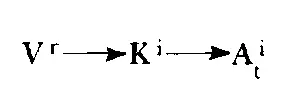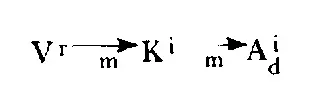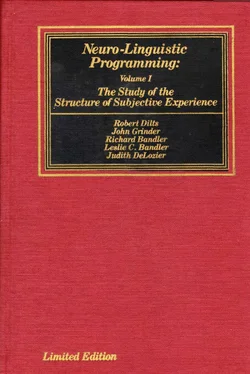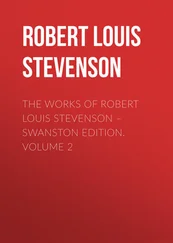For example, if an individual is deciding whether or not to take a swim, he may go through a strategy in which he looks up and to the left and sees how it looked through his own eyes the last time he was swimming, in his mind's eye. A congruent response to this image in the kinesthetic system would be experiencing the body sensations of physically being in the water. A congruent response, in turn, to these body sensations in the auditory tonal representational modality would be hearing the sounds of the water lapping the edges of the pool and covering his ears as he ducks below the water surface.
We will notate a congruent response by simply using an arrow " '", to point from the initiating step to the one that is a congruent response to it. In the case of our example:

b. A polarity response will be defined as a representation which is essentially a reversal in content of the step preceding it. For instance, if the individual in the above example had made the internal image of swimming described above and, rather than experience the body sensations of being in the water, had felt frightened or nauseous, this would constitute a polarity response kinesthetically.
Note that hearing the sounds of the water of the pool following this kinesthetic experience would constitute a polarity response to the feelings. Hearing a worried tone of voice in internal dialogue would constitute a congruent response to the kinesthetic sensations.
We notate a polarity response as an arrow with a "p" beneath it between the two steps in question. Thus we would show the frightened feelings in response to the image, in this example, as:

c. A meta response is denned as a response about the step before it, rather than a continuation or reversal of the representation. These responses are more abstracted and disassociated from the representation preceding them. Getting feelings about the image (feeling that something may have been left out of the picture, for instance) that the individual had made of what it would look like to be swimming, rather than in direct response to the content of that image, would constitute a meta response in our example. Saying to himself, "I wonder if feeling this way means that I actually don't want to go swimming?" would be an internal auditory–digital meta response to these meta feelings.
We will notate the meta response modifier as an arrow between the steps with "m" beneath it, ". We would show the three steps described in the paragraph above, then, as:

Remember that these distinctions are purely a matter of punctuation — of how a particular strategy step is related to the steps around it. A representation which constitutes a meta response to one step may constitute a congruent response or a polarity response to some other step (and vice versa) even though it is the exact same representation. These modifiers are not the result of physiological differences in neural structures or processes, as are the other modifiers we have presented. That is, there is no separate portion of our neurology set aside for congruent, polarity or meta responses. The significance of these distinctions is purely in relation to the steps that provide the context in which the representation occurs; they provide information about the relative contents of the representations in the strategy.
As with all of the modifiers presented, we strongly suggest that you only employ these distinctions when they are important or useful to achieving the outcome you are attempting to secure.
These distinctions are the least rigorously defined and identifiable of those we have presented in this book. They can, however, be extremely useful to you at times in identifying patterns of behavior. For instance, you may notice that someone will consistently have a kinesthetic polarity response to verbal directions (A e d,t) from external sources, but a congruent response if she gives herself the directions with her own internal dialogue in her own tone of voice (A i d,t), even if it is exactly the same words she heard externally. Some people will have great difficulty in making decisions because their strategy involves a long string of meta responses, each about the step that has come before it, so they never get around to directly confronting the issues involved because they are caught up in their own processes. Conversely, other people who only respond with congruent responses may experience themselves as having no choices, because they can never think about what they are doing until after they have already gone through the behavior.
3.242 Applying the New Modifiers.
Returning to EXAMPLE A of the decision making strategy we analyzed earlier in this section, we will apply these modifiers to make a more explicit analysis of the administrator's strategy as a means to assist us in accessing more resources for her and for ourselves. We can now add the following distinctions to our analysis:
1) The feelings that the individual has derived from her testing of the report material are a meta response — "I get the feeling that something may have been left out." These feelings are obviously not a congruent continuation of the content presented in the report, nor are they a negation or reversal of the content. A congruent response might be, "This proposal catches my feelings exactly." A polarity response might state, "My feeling is that we have to take an entirely different approach."
2) The administrator begins her operation with a meta auditory digital response about the feelings: "I have to ask myself, how might this affect the results of this decision?" A congruent response would be something like, "… and I say to myself, 'yes, something really is missing'." A polarity response would have gone something like, "… but a part of me says, 'it's really as complete as it can be'."
3) At this point in the elicitation process it is uncertain whether the images the administrator constructs from this verbalization are meta, polarity or congruent responses, although we can postulate from the context in which they appear that they are probably congruent responses to the verbal question, "How might this affect the results of this decision?"
4) The relationship of the feelings is also not specified verbally. However, it is likely that they are feelings about the images being made — a meta response.
5) The final auditory digital step is a meta response as well. She is saying that she doesn't know what to say — clearly a response about the step.
The fully notated strategy, then, adding in the new modifiers, looks like:

We have put question marks under the constructed visual and the second kinesthetic steps to show that they aren't yet verified. In general, when the nature of the response is not specified, we simply show an arrow by itself "→".
To complete the elicitation process in this example, to help the person access the appropriate resources needed to make the decision, you have a number of choices available:
a) You could gather more information, specifying the relationship between (1) the constructed visual images and the preceding auditory digital response by asking questions like, "Just how do you picture the effects that the information you feel is missing might have on the results?" (2) the kinesthetic response and the constructed images, by asking questions like, "What kind of feelings do you get as you look at the possible effects of the missing information?"
Читать дальше















